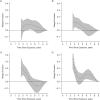Flexible Modeling of the Association Between Cumulative Exposure to Low-Dose Ionizing Radiation From Cardiac Procedures and Risk of Cancer in Adults With Congenital Heart Disease
- PMID: 31107497
- PMCID: PMC6670051
- DOI: 10.1093/aje/kwz114
Flexible Modeling of the Association Between Cumulative Exposure to Low-Dose Ionizing Radiation From Cardiac Procedures and Risk of Cancer in Adults With Congenital Heart Disease
Abstract
Adults with congenital heart disease are increasingly being exposed to low-dose ionizing radiation (LDIR) from cardiac procedures. In a recent study, Cohen et al. (Circulation. 2018;137(13):1334-1345) reported an association between increased LDIR exposure and cancer incidence but did not explore temporal relationships. Yet, the impact of past exposures probably accumulates over years, and its strength may depend on the amount of time elapsed since exposure. Furthermore, LDIR procedures performed shortly before a cancer diagnosis may have been ordered because of early symptoms of cancer, raising concerns about reversal causality bias. To address these challenges, we combined flexible modeling of cumulative exposures with competing-risks methodology to estimate separate associations of time-varying LDIR exposure with cancer incidence and all-cause mortality. Among 24,833 patients from the Quebec Congenital Heart Disease Database, 602 had incident cancer and 500 died during a follow-up period of up to 15 years (1995-2010). Initial results suggested a strong association of cancer incidence with very recent LDIR exposures, likely reflecting reverse causality bias. When exposure was lagged by 2 years, an increased cumulative LDIR dose from the previous 2-6 years was associated with increased cancer incidence, with a stronger association for women. These results illustrate the importance of accurate modeling of temporal relationships between time-varying exposures and health outcomes.
Keywords: cancer epidemiology; competing risks; splines; time-varying exposure.
© The Author(s) 2019. Published by Oxford University Press on behalf of the Johns Hopkins Bloomberg School of Public Health. All rights reserved. For permissions, please e-mail: journals.permissions@oup.com.
Figures



Similar articles
-
Exposure to Low-Dose Ionizing Radiation From Cardiac Procedures and Malignancy Risk in Adults With Congenital Heart Disease.Circulation. 2018 Mar 27;137(13):1334-1345. doi: 10.1161/CIRCULATIONAHA.117.029138. Epub 2017 Dec 21. Circulation. 2018. PMID: 29269389
-
Comparison of cancer risk associated with low-dose ionizing radiation from cardiac imaging and therapeutic procedures after acute myocardial infarction in women versus men.Am J Cardiol. 2013 Nov 15;112(10):1545-50. doi: 10.1016/j.amjcard.2013.07.009. Epub 2013 Aug 22. Am J Cardiol. 2013. PMID: 23972348
-
Exposure to Low-Dose Ionizing Radiation From Cardiac Procedures in Patients With Congenital Heart Disease: 15-Year Data From a Population-Based Longitudinal Cohort.Circulation. 2016 Jan 5;133(1):12-20. doi: 10.1161/CIRCULATIONAHA.115.019137. Epub 2015 Nov 4. Circulation. 2016. PMID: 26538581
-
Concise Review: The Effect of Low-Dose Ionizing Radiation on Stem Cell Biology: A Contribution to Radiation Risk.Stem Cells. 2018 Aug;36(8):1146-1153. doi: 10.1002/stem.2836. Epub 2018 May 17. Stem Cells. 2018. PMID: 29664142 Review.
-
Low dose or low dose rate ionizing radiation-induced health effect in the human.J Environ Radioact. 2018 Dec;192:32-47. doi: 10.1016/j.jenvrad.2018.05.018. Epub 2018 Jun 5. J Environ Radioact. 2018. PMID: 29883875 Review.
Cited by
-
Latency estimation for chronic disease risk: a damped exponential weighting model.Eur J Epidemiol. 2020 Sep;35(9):807-819. doi: 10.1007/s10654-020-00658-9. Epub 2020 Jul 30. Eur J Epidemiol. 2020. PMID: 32728914 Free PMC article.
-
In-Depth Genomic Analysis: The New Challenge in Congenital Heart Disease.Int J Mol Sci. 2024 Feb 1;25(3):1734. doi: 10.3390/ijms25031734. Int J Mol Sci. 2024. PMID: 38339013 Free PMC article. Review.
-
Risk of malignancy in adult patients with congenital heart disease: a clinical practice review.Cardiovasc Diagn Ther. 2025 Feb 28;15(1):195-206. doi: 10.21037/cdt-24-388. Epub 2025 Feb 25. Cardiovasc Diagn Ther. 2025. PMID: 40115083 Free PMC article. Review.
-
Nurse staffing practices and adverse events in acute care hospitals: The research protocol of a multisite patient-level longitudinal study.J Adv Nurs. 2021 Mar;77(3):1567-1577. doi: 10.1111/jan.14710. Epub 2020 Dec 10. J Adv Nurs. 2021. PMID: 33305473 Free PMC article.
-
Comparison of Different Modeling Approaches for Prescription Opioid Use and Its Association With Adverse Events.Am J Epidemiol. 2023 Sep 1;192(9):1592-1603. doi: 10.1093/aje/kwad115. Am J Epidemiol. 2023. PMID: 37191340 Free PMC article.
References
-
- Pearce N. Methodological problems of time-related variables in occupational cohort studies. Rev Epidemiol Sante Publique. 1992;40(suppl 1):S43–S54. - PubMed
-
- Checkoway H, Pearce N, Hickey JL, et al. . Latency analysis in occupational epidemiology. Arch Environ Health. 1990;45(2):95–100. - PubMed
-
- Vacek PM. Assessing the effect of intensity when exposure varies over time. Stat Med. 1997;16(5):503–513. - PubMed
-
- Rothman KJ. Induction and latent periods. Am J Epidemiol. 1981;114(2):253–259. - PubMed
Publication types
MeSH terms
Grants and funding
LinkOut - more resources
Full Text Sources
Medical
Miscellaneous

